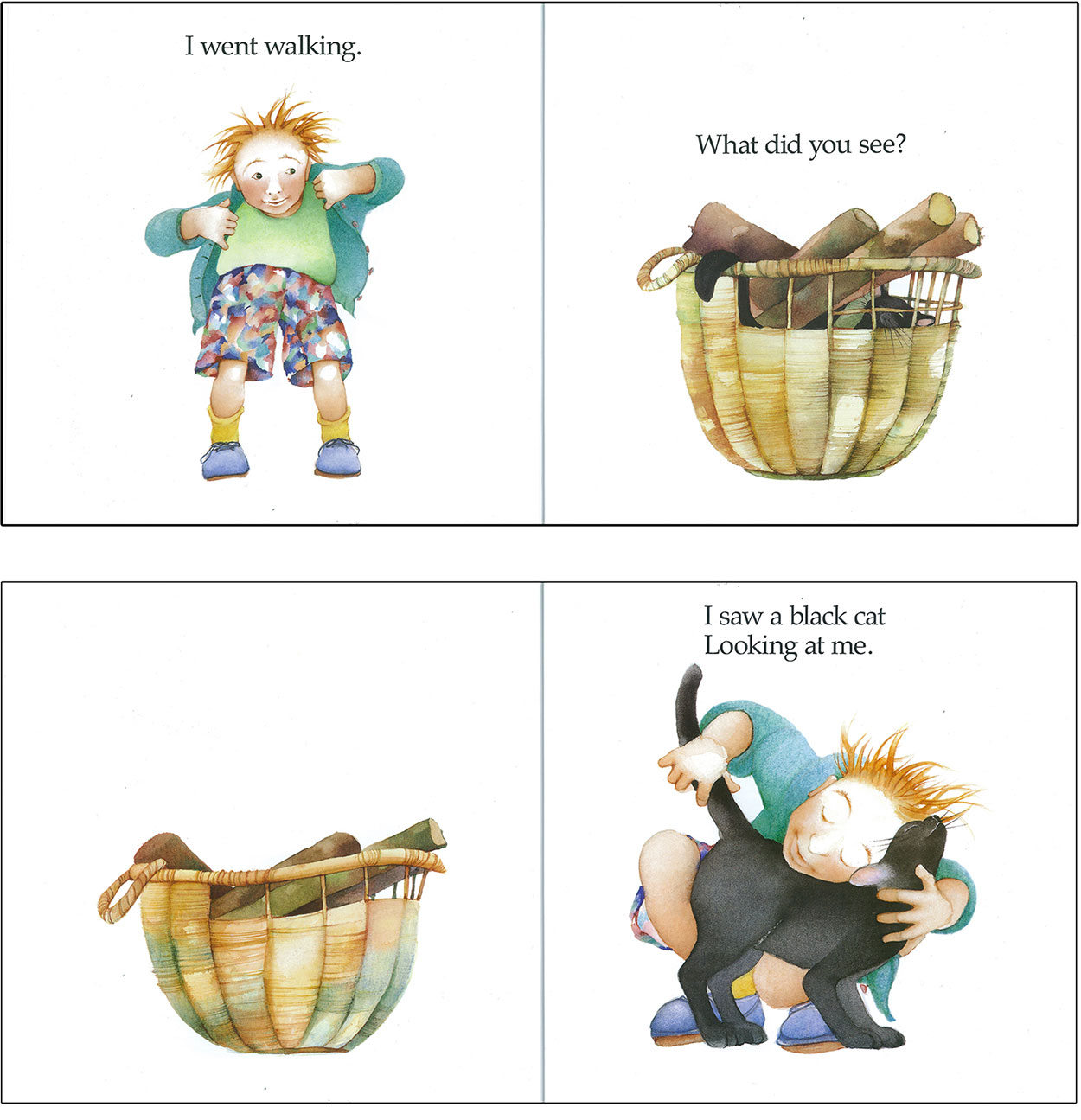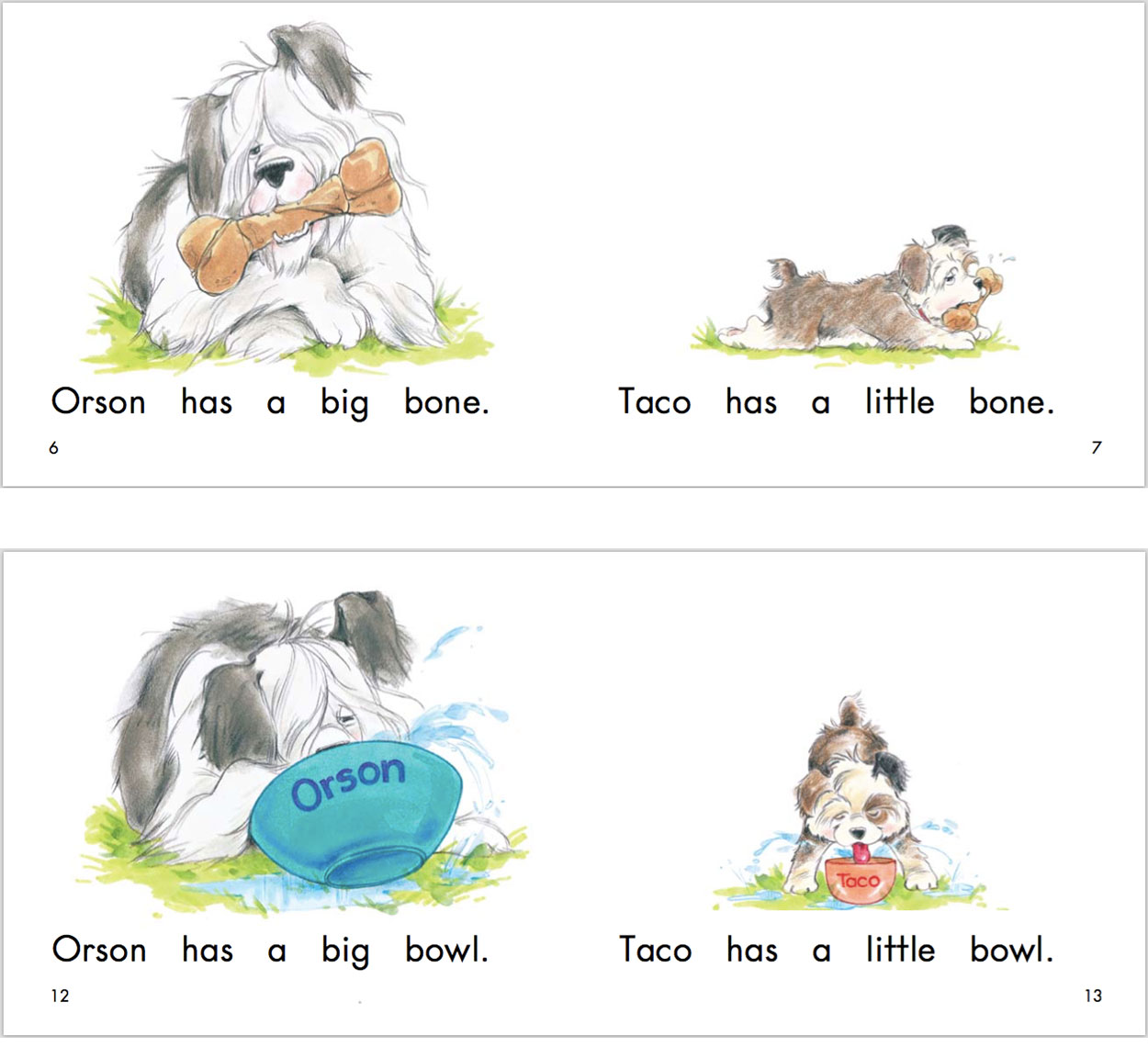The good
Toddlers and preschoolers adore picture books with predictable language because they can emulate reading without needing to decode. Young children love Brown, Bear Brown Bear, What Do You See? and I Went Walking and Silly Sally because the repeating sentence patterns and big, bold, colorful illustrations allow them to confidently “read” the books by memorizing the patterns and looking at the pictures.

Predictable books pique children’s interest in reading and can be used to teach concepts of print (how to hold a book, turn the pages, and point to the words).
Publishers Weekly describes I Went Walking as “a kind of guessing game that little ones will enjoy playing again and again.” Delighting prereaders with predictable books makes instructional sense in preschool and, perhaps, even part way into kindergarten, but in elementary classrooms these guessing games continue well past the point of developmental appropriateness, to the detriment of children’s reading progress.
The bad
Leveled books are so ubiquitous that teachers and parents may have a difficult time imagining reading instruction without them. Books at the lowest levels are predictable, like the text below, Friends, which is from a first grade reading intervention program that purports to serve struggling readers.

To actually read Friends, and predictable books like it, a child would need to have command of phonics — short vowels (big), long vowels (bone), diphthongs (bowl), consonant-le words (little) — and, if that were the case, the child would not be a struggling reader.
But children don’t actually read Friends, they recite sentences from memory, perhaps pointing to words on the page, and they use pictures and knowledge of the story to approach the text as if reading were a game of memory and strategic guessing.
According to the accompanying lesson plan, the teacher introduces Friends by saying:
“This book is called Friends. These two dogs are friends. The big dog is Orson (point to tag on collar) and the little dog is Taco (point to tag).”
The introduction continues with a read-aloud of the entire text in which the teacher points to and reads each word and discusses the illustrations with the students. By the time children receive their own copies of the text they are prepared to recite the story from memory.
This instruction might be appropriate in a preschool classroom, but it does nothing to serve the needs of the first-graders for whom the lesson is intended. In fact, it may further delay their reading development.
“[This model of instruction] fosters dependence on pictures, prereading rehearsal, and context for identifying words. Unfortunately, these are the strategies that poor readers rely on when they are having difficulty deciphering the alphabetic code.”
— Language Essentials for Teachers of Reading and Spelling
Why do students in reading intervention so often receive lessons that are at odds with their instructional needs?
The misconception
Reading “experts” and their publishers have developed and promoted instructional materials that intentionally frame reading as if it were a guessing game. In fields such as neuroscience and cognitive psychology, the neurology of reading is well understood, but many educational leaders have clung to a disproven belief that reading is a “psycholinguistic guessing game.” Kenneth Goodman, a “founding father” of whole language instruction, wrote:
“Skill in reading involves not greater precision but more accurate first guesses based on better sampling techniques, greater control over language structure, broadened experiences, and increased conceptual development. As the child develops reading skill and speed, he uses increasingly fewer graphic cues.”
— Goodman, 1967
Predictable books have flooded elementary school classrooms, intervention rooms, and children’s book bags because educators have misunderstood what it takes to become a skilled reader. In the manual that accompanies Friends, the program’s authors, Irene Fountas and Gay Su Pinnell, explain to teachers:
“You want readers to have and use many ways to solve or analyze words.”
— Leveled Literacy Intervention Program Guide, p. 89
This misguidance can be traced back to Marie Clay, who developed the Reading Recovery intervention program that is now widely used in American schools. She believed, inaccurately, that:
All readers, from five year old beginners to the effective adult reader, need to use the sentence structure, order cues, size cues, features, special knowledge, first and last letter knowledge before they resort to left to right sounding out of chunks or letter clusters, or in the last resort, single letters.”
Predictable books are purpose-written to teach children not to rely on phonics because the idea underpinning their construction is that readers should predict words using meaning and sentence structure, and attend to “graphic cues” (letters) as little as possible. Texts, like Friends, are intentionally written to include phonics that students have not been taught in an effort to discourage readers from attending to the letters in words.
The belief that students need to be taught strategies to avoid decoding can be found in elementary instruction, curricula, and assessments. When a child “reads” predictable texts, the teacher will often complete a “running record,” an assessment that helps her to analyze the compensatory strategies the child uses to avoid decoding words.
Does the child use the meaning of the story to guess what a word might be?
- I Went Walking: “I went walking. What did you see? I saw a [color] [animal] looking at me.”
- Friends: “Orson has a big [dog-related object]. Taco has a little [same dog-related object].”
Does the child use the sentence structure to approach reading the text as if it were a game of fill in the blanks?
- I Went Walking: “I went walking. What did you see? I saw a [adjective] [noun] looking at me.”
- Friends: “Orson has a big [noun]. Taco has a little [same noun].”
Does the child use visuals to approach the book as a matching game?
- I Went Walking: picture of a cat’s tail extruding from a basket. “A cat!”
- Friends: picture of a bowl? A dish? And a word beginning with the letter B. “A bowl!”
In running records and guided reading lessons, the strategies a child uses to guess words (meaning, sentence structure and visuals) are framed as the reader’s strengths, but these are actually warning signs that a child can’t read the words.
While there are many ways to figure out what a word might be, there is only one way to read it. Readers build skill by decoding words — at first very deliberately but then effortlessly and unconsciously. By attending to spelling patterns in words, we learn to connect the print on the page with spoken language (bowl = /b/ /ō/ /l/). Decoding is reliable because 50% of English words are entirely decodable and another 34% can be sounded out with just a little shift in pronunciation (in-de-pen-dent = “induhpendent”). For more, see How Words Cast Their Spell .
If children learn to decode while using predictable texts that is despite, not because of, the books they’ve received.
The consequences
Some children learn to read because even though they’ve been given predictable books and guided reading, they discover that the most reliable way to pronounce a word is to attend to its letters. But others are not so fortunate.
“That children who are so taught aren’t actually learning to read becomes clear when they attempt to read an unfamiliar text for the first time and are stymied.”
“… whatever else a particular intervention accomplishes for at-risk children, if it does not significantly impact their ability to read words fluently and accurately in text, then it has not addressed a primary problem they experience in becoming good readers.”
Children who struggle to crack the code of written English may spend years in elementary school flipping through predictable books, approaching reading as if it were a guessing game. To move out of lower level books, children have to stop predicting words and start paying attention to the letters on the page. But when guessing and skipping strategies have become second nature, it’s difficult for struggling readers to change gears and accept that they need to decode every word. Shifting from predicting to sounding out words can be frustrating and labor-intensive for the student (and the parent or teacher).
The solution
The time spent with predictable books would be better spent with “decodable texts,” which include only words that beginning readers can sound out with the phonics they have been taught. Decodables provide readers with a purpose for learning and applying phonics. Like predictable books, decodables are purpose-written and are not “authentic” texts. But their goals could not be more different.
Predictable books aim to teach children to predict words, while decodables aim to support decoding instruction. We undermine phonics instruction when we hand children predictable books because the texts are purpose-written to show children that predicting words is a viable alternative to sounding them out.
Predictable books may be everywhere, but that doesn’t mean that elementary school children (and teachers) should be using them. If we want our children to become skilled readers and attend to words as they read, we need to use materials that teach them to value the letters on the page.

